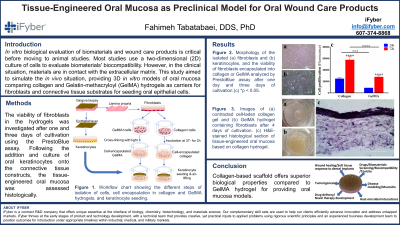Laboratory Research
(LR-052) Tissue-Engineered Oral Mucosa as Preclinical Model for Oral Wound Care Products
Friday, April 28, 2023
7:15 PM - 8:30 PM East Coast USA Time

Introduction: Oral wound care products need to be evaluated in vitro using 3D models of the oral mucosa. The first step in oral mucosal tissue engineering is to prepare the lamina propria by loading fibroblasts into a suitable scaffold material that can act as a substrate for the subsequent seeding of epithelial cells. The material selected as the fibroblast carrier must meet several requirements, including the ability to mimic the extracellular matrix of connective tissues, allow fibroblast proliferation, and support epithelial cell adhesion and differentiation. This study aimed to compare collagen and GelMA hydrogels as carriers for fibroblasts and connective tissue substrates for seeding oral epithelial cells.
Methods: Human primary oral fibroblast and keratinocyte cells were isolated from gingival biopsies. The mixture of fibroblasts with GelMA or collagen gel were aliquoted within six-well tissue culture plate inserts and cross-linked using visible light or reconstitution buffer/heat, respectively. The viability of fibroblasts in the hydrogels was investigated after one and three days of cultivation using the PrestoBlue assay. Following the addition and culture of oral keratinocytes onto the connective tissue constructs, the tissue-engineered oral mucosa was assessed histologically.
Results: The tissue viability assay shows that collagen hydrogels encapsulating fibroblasts displayed significantly higher cell viability than cell-laden GelMA constructs after 24 and 72 h (p < 0.05). A stratified and differentiated epithelium has formed on the surface of cell-laden collagen hydrogel but not on the surface of the GelMA-based substrate.
Discussion: Collagen-based scaffold offers superior biological properties compared to GelMA hydrogel in terms of oral fibroblast growth, as well as epithelial cell adhesion and differentiation. Therefore, collagen-based hydrogels remain the preferred choice for oral mucosa tissue engineering. Further studies are required to explore the potential approaches in modifying GelMA to improve its properties in terms of epithelial cell adhesion. Development and evaluation of hydrogel scaffolds based on a combination of GelMA with collagen or other natural scaffolds, as well as different surface coating with bio-active materials, could be the potential avenues to overcome the challenges observed in this study.
Methods: Human primary oral fibroblast and keratinocyte cells were isolated from gingival biopsies. The mixture of fibroblasts with GelMA or collagen gel were aliquoted within six-well tissue culture plate inserts and cross-linked using visible light or reconstitution buffer/heat, respectively. The viability of fibroblasts in the hydrogels was investigated after one and three days of cultivation using the PrestoBlue assay. Following the addition and culture of oral keratinocytes onto the connective tissue constructs, the tissue-engineered oral mucosa was assessed histologically.
Results: The tissue viability assay shows that collagen hydrogels encapsulating fibroblasts displayed significantly higher cell viability than cell-laden GelMA constructs after 24 and 72 h (p < 0.05). A stratified and differentiated epithelium has formed on the surface of cell-laden collagen hydrogel but not on the surface of the GelMA-based substrate.
Discussion: Collagen-based scaffold offers superior biological properties compared to GelMA hydrogel in terms of oral fibroblast growth, as well as epithelial cell adhesion and differentiation. Therefore, collagen-based hydrogels remain the preferred choice for oral mucosa tissue engineering. Further studies are required to explore the potential approaches in modifying GelMA to improve its properties in terms of epithelial cell adhesion. Development and evaluation of hydrogel scaffolds based on a combination of GelMA with collagen or other natural scaffolds, as well as different surface coating with bio-active materials, could be the potential avenues to overcome the challenges observed in this study.

.png)